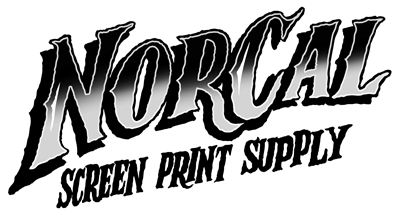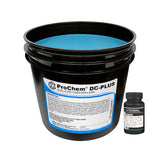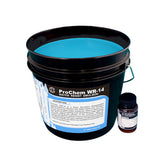Tips on Selecting Emulsion
Emulsion is the light sensitive liquid used to create a stencil on the screen. It is one of the most important components in creating a good stencil, as well as a good print!
In a nutshell, you can generally select your emulsion based on your exposure method or unit:
500w Halogen Shop Light - Use a Diazo or Dual Cure emulsion like DC-PLUS or WR-14 Water Resistant Emulsion for Waterbase Inks
Tube UV Bulb Exposure Unit - Use a Photopolymer such as VPR or PFX-HV
LED Exposure Unit - Use a Photopolymer such as VPR, PFX-HV or Photo Blue
Main types of emulsion
Diazo Emulsion is a basic, all purpose emulsion. It has the lowest sensitivity to light, and has a wide exposure window. It is usually not used for tiny detail. If you are exposing your screens using a shop light or other lower power light source, diazo emulsion is probably your best choice. Diazo emulsions must be "sensitized" using the diazo powder that ships with them.
Dual Cure Emulsions offer mid range exposure times. They are usually not as thick as diazo emulsions, and usually provide better results for very fine detail. Dual cure emulsions also come with Diazo powder, which is used to activate the emulsion.
Photopolymer Emulsions offer the highest sensitivity to light and the fastest exposure times. They have a narrower exposure window, so you have to dial in your exposure time. They are great for tiny detail and small halftone dots.. These emulsions work well with high output exposure units, but are also suitable for tabletop uv bulb exposure units. Photopolymer emulsions are also a little more convenient since they come ready to use, with no activation necessary.
Note*
If you are printing with waterbase and discharge inks, you will want to choose an emulsion that is water resistant, and will not break down.
Other tips:
Your stencil should be free of pinholes if possible, and hold up to hundreds, if not thousands of squeegee passes.
Avoid Dirt and Dust
Do your best to keep your emulsion free of dust and in a clean area .
Use a Good Scoop Coater
Invest in a good scoop coater for your emulsion. This helps get the emulsion on evenly when applying emulsion to your screens.
Allow Screens to Dry Thoroughly
After coating screens with emulsion, make sure to let them dry completely before beginning production. Two hours is usually a good minimum dry time depending on air moisture, temperature and ventilation. Often, fans are used to speed the drying times for newly coated screens, but care should be taken not to blow dust or dirt onto the newly coated screens.
Here are some of the emulsions we offer currently:
|
Best Seller: VPR |
Dual Cure: DC-Plus |
Water Resistant: WR-14 |




